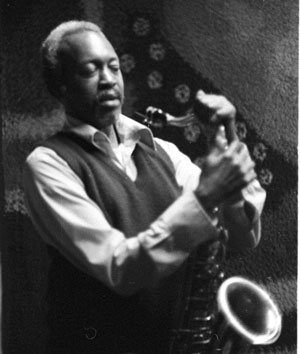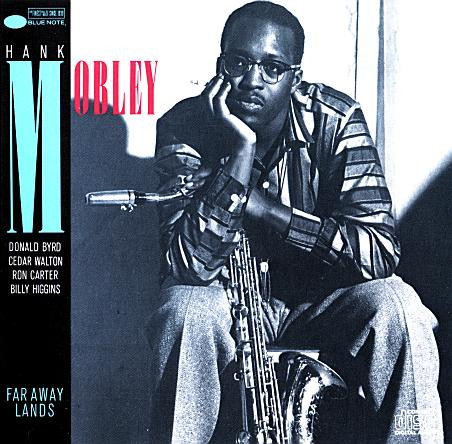Bossa For Baby – Hank Mobley
A charming bossa with a tag at the end of every chorus. Second parts and a condensed score are available for the quintet arrangement.
- Recording: Hank Mobley - Far Away Lands
- Recorded on: May 26, 1967
- Label: Blue Note (BST 84425)
- Concert Key: F
- Vocal Range: , to
- Style: Latin (Bossa)
- Trumpet - Donald Byrd
- Tenor Sax - Hank Mobley
- Piano - Cedar Walton
- Bass - Ron Carter
- Drums - Billy Higgins
0:00
0:00
Buy MP3
Purchase Bossa For Baby - Hank Mobley
Purchasing this song through our affiliate links with certain retailers provides jazzleadsheets.com with additional support to help keep us bringing you the best lead sheets available. Thank you!
Video
- Description
- Historical Notes
- Solos
- Piano Corner
- Bass Corner
- Drum Corner
- Guitar Corner
- Inside & Beyond
- Minus You
A warm-toned bossa with a classic '60s Blue Note sound, Bossa For Baby showcases Hank Mobley's signature melodic style. The melody combines snappy rhythmic figures with more lyrical lines, often within the same phrase as in the first four measures. The ABCD form, with A and C the same and D starting the same as B, is expanded to 38 measures by a six-measure tag at the end, which alternates Fmaj7 and G♭7. This tag is played in the solos as well as the head. The changes are relatively simple but spiced with tasteful modulations and substitutions. A II-V7 to D♭ major in the second through fourth measures, combined with an A♭ in the melody, almost implies an F minor tonality, but a return to F major in the seventh measure is marked dramatically by the first A♮ in the melody. The eighth measure has a tritone substitute II-V7 going to B♭maj7, while the fifth and sixth measures of D use D♭7 and G♭7 to resolve back to F.
The ending shown in our lead sheets is different from the recording, which vamps and fades out on the tag. We indicate to end at the second to last measure, which certainly works as an alternate ending with or without vamping the tag.
The lead sheets would be the first parts of the quintet arrangement. We have second parts and a concert condensed score, also. The horns play mostly in octaves, but harmonize in sixths in the third and fourth measures of D; on the tag they play in thirds.
Our alto sax second part is in unison with the melody until the harmonized sections; an octave lower would go below the alto's range. The condensed score is also the rhythm section part; it shows the changes for the eight-measure rhythm section intro. Also as shown in the score, on the recording the first chord of the in head is actually F minor. This may have been a mistake—all solo choruses and the out head start in major—but it certainly works in context and establishes the dramatic contrast of the Fmaj7 in the seventh measure.
The ending shown in our lead sheets is different from the recording, which vamps and fades out on the tag. We indicate to end at the second to last measure, which certainly works as an alternate ending with or without vamping the tag.
The lead sheets would be the first parts of the quintet arrangement. We have second parts and a concert condensed score, also. The horns play mostly in octaves, but harmonize in sixths in the third and fourth measures of D; on the tag they play in thirds.
Our alto sax second part is in unison with the melody until the harmonized sections; an octave lower would go below the alto's range. The condensed score is also the rhythm section part; it shows the changes for the eight-measure rhythm section intro. Also as shown in the score, on the recording the first chord of the in head is actually F minor. This may have been a mistake—all solo choruses and the out head start in major—but it certainly works in context and establishes the dramatic contrast of the Fmaj7 in the seventh measure.
"Far Away Lands" was recorded at the legendary Van Gelder Studio in Englewood Cliffs.
Hank Mobley reused the B section melody of Bossa For Baby in a later composition, Home At Last, the third movement of the title suite on Hank's final Blue Note album "Thinking Of Home." "Far Away Lands" is the second of three consecutive Mobley albums with original bossas, between "Third Season" (Boss Bossa) and "Hi Voltage" (Bossa De Luxe).
Bossa For Baby is one of Hank Mobley's more frequently played later compositions. Among several recent recordings of this song are two versions by tenor saxophonist Houston Person, in 2005 and 2018. Tenor saxophonist Cory Weeds recorded this song and five others by Mobley (including Up A Step and Up, Over, And Out) on his 2002 tribute album "Up A Step."
Hank Mobley reused the B section melody of Bossa For Baby in a later composition, Home At Last, the third movement of the title suite on Hank's final Blue Note album "Thinking Of Home." "Far Away Lands" is the second of three consecutive Mobley albums with original bossas, between "Third Season" (Boss Bossa) and "Hi Voltage" (Bossa De Luxe).
Bossa For Baby is one of Hank Mobley's more frequently played later compositions. Among several recent recordings of this song are two versions by tenor saxophonist Houston Person, in 2005 and 2018. Tenor saxophonist Cory Weeds recorded this song and five others by Mobley (including Up A Step and Up, Over, And Out) on his 2002 tribute album "Up A Step."
Related Songs
Email Send Bossa For Baby to a friend
Send this page to a friend via email. Add your name or email in the first field. In the second, add one or more email addresses, separated by a comma.

Hank Mobley
July 7, 1930 – May 30, 1986
Hank Mobley is one of the most acclaimed tenor saxophonists in modern jazz history. He is recognized by musicians and critics alike as one of the most important and eloquent jazz instrumentalists of all time. He recorded well over 100 of his own original compositions and left an indelible mark on the post-bop jazz scene. Read more...
There was a problem.
...

